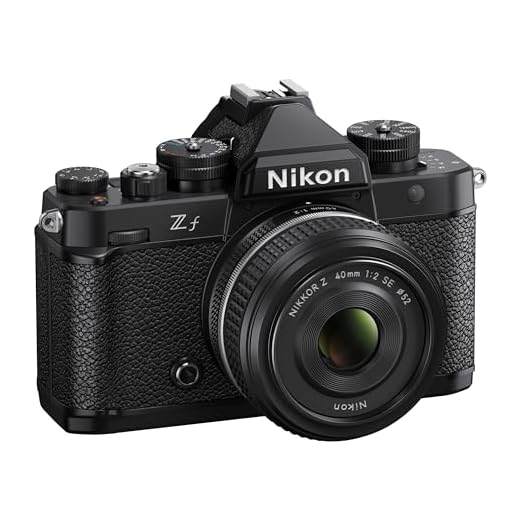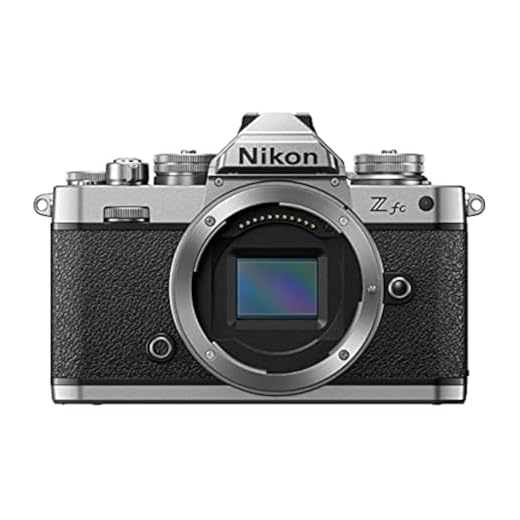Nikon Z fc vs Nikon Zf
When it comes to choosing a mirrorless camera, the Nikon Z fc and Nikon Zf are two models that stand out. Both cameras offer a range of impressive features, but they also have distinct differences that can influence a potential buyer’s decision. This comprehensive comparison of Nikon Z fc vs Nikon Zf will explore key parameters such as design, optics, videography capabilities, and additional features to help you determine which camera best suits your needs.


Nikon Z fc vs Nikon Zf: Detailed Comparison
| Feature | Nikon Z fc | Nikon Zf |
|---|---|---|
| Type | Mirrorless | Mirrorless |
| Viewfinder | Electronic viewfinder (EVF), Optical viewfinder (OVF) | Electronic viewfinder (EVF) |
| Is weather-sealed (splashproof) | ✖ | ✔ |
| Screen resolution | 1040k dots | 2100k dots |
| EVF resolution | 2360k dots | 3690k dots |
| Has a built-in focus motor | ✖ | ✖ |
| Has a flip-out screen | ✔ | ✔ |
| Viewfinder coverage | 100% | 100% |
| Screen size | 3″ | 3.2″ |
| Weight | 445 g | 710 g |
| Has a touch screen | ✔ | ✔ |
| Has a hot shoe | ✔ | ✔ |
| Volume | 547.05 cm³ | 726.77 cm³ |
| Is a system camera | ✔ | ✔ |
| Has a flash | ✖ | ✖ |
| Lowest potential operating temperature | 0 °C | n.a. |
| Maximum operating temperature | 40 °C | n.a. |
| Has a tilting viewfinder | ✖ | ✖ |
| Width | 134.5 mm | 144 mm |
| Height | 93.5 mm | 103 mm |
| Thickness | 43.5 mm | 49 mm |
| Sensor size | APS-C | Full frame |
| Lens mount | Nikon Z | Nikon Z |
| Focus points | 209 | 273 |
| Megapixels (main camera) | 20.9 MP | 24.5 MP |
| Maximum ISO | 51200 ISO | 64000 ISO |
| Maximum expanded ISO | 204800 ISO | 204800 ISO |
| Has sensor shift stabilization | ✖ | ✔ |
| Continuous shooting (mechanical) | 11 fps | 14 fps |
| Has AF tracking | ✔ | ✔ |
| Has phase-detection autofocus for photos | ✔ | ✔ |
| Fastest shutter speed | 1/4000 s | 1/8000 s |
| Has manual focus | ✔ | ✔ |
| Has touch autofocus | ✔ | ✔ |
| Has manual shutter speed | ✔ | ✔ |
| Has a built-in HDR mode | ✖ | ✖ |
| Has a BSI sensor | ✔ | ✔ |
| Has manual exposure | ✔ | ✔ |
| Has a two-stage shutter | ✔ | ✔ |
| Has a serial shot mode | ✔ | ✔ |
| Has a CMOS sensor | ✔ | ✔ |
| Has manual ISO | ✔ | ✔ |
| Flash sync speed | 1/200 s | 1/250 s |
| Has manual white balance | ✔ | ✔ |
| Can create panoramas in-camera | ✖ | ✖ |
| Exposure time | 30 s | 30 s |
| Expeed version | 6 | n.a. |
| Has a stacked CMOS sensor | ✖ | ✖ |
| Image stabilization rating (CIPA) | ∅ | 8 stops |
| Can combine image stabilization | ✔ | ✔ |
| Video recording (main camera) | 2160 x 30 fps | 2160 x 30 fps |
| Has phase-detection autofocus for videos | ✔ | ✔ |
| Has continuous autofocus when recording movies | ✔ | ✔ |
| Has a microphone input | ✔ | ✔ |
| Has a socket for a 3.5 mm audio jack | ✔ | ✔ |
| Has a stereo microphone | ✔ | ✔ |
| Has timelapse function | ✔ | ✔ |
| Number of microphones | 2 | 2 |
| Has a 24p cinema mode | ✔ | ✔ |
| Supports slow-motion video recording | ✔ | ✔ |
| Battery life (CIPA) | 300 shots | 380 shots |
| Has a removable battery | ✔ | ✔ |
| Has a rechargeable battery | ✔ | ✔ |
| Has a battery level indicator | ✔ | ✔ |
| Battery power | 1120 mAh | n.a. |
| Supports Wi-Fi | ✔ | ✔ |
| Has Bluetooth | ✔ | ✔ |
| Has dual card slots | ✖ | ✖ |
| Has pixel shift shot | ∅ | ✔ |
| Shoots RAW | ✔ | ✔ |
| Supports lossless compressed RAW | ✖ | ✔ |
| Wi-Fi version | Wi-Fi 5 (802.11ac), Wi-Fi 4 (802.11n) | Wi-Fi 5 (802.11ac), Wi-Fi 4 (802.11n) |
| Supports a remote smartphone | ✔ | ✔ |
| Has an HDMI output | ✔ | ✔ |
| Has GPS | ✖ | ✖ |
| Has first-party support for live streaming | ✖ | ✖ |
| Has an advanced hot shoe | ✖ | ✖ |
| USB version | n.a. | 3.2 |
| Has NFC | ✖ | ✖ |
| Has an external memory slot | ✔ | ✔ |
| Has USB Type-C | ✔ | ✔ |
| Bluetooth version | Unknown | 5 |
Design and Build Quality
The Nikon Z fc and Nikon Zf are both mirrorless cameras, which means they are generally more compact and lighter than traditional DSLR cameras. The Nikon Z fc weighs 445 grams, making it a lightweight option for photographers who prioritize portability. In contrast, the Nikon Zf weighs 710 grams, which is significantly heavier but may offer a more robust feel.
Both cameras feature electronic viewfinders (EVF), but the Nikon Z fc also includes an optical viewfinder (OVF), providing users with more flexibility. The Nikon Zf boasts a higher EVF resolution of 3690k dots compared to the Z fc’s 2360k dots, offering a sharper and clearer image for framing and focusing. Additionally, the Nikon Zf is weather-sealed, providing better protection against dust, raindrops, and water splashes, which the Nikon Z fc lacks.
Screen and Usability
Screen resolution and size are important factors for photographers who rely on live view and playback. The Nikon Zf excels with a screen resolution of 2100k dots, surpassing the Z fc’s 1040k dots. Both models feature flip-out screens, enhancing versatility for shooting at various angles. The Zf’s screen is slightly larger at 3.2 inches compared to the Z fc’s 3 inches, providing a larger view for reviewing images and navigating menus.
Optical Performance
The sensor size is a critical aspect of image quality. The Nikon Z fc has an APS-C sensor, while the Nikon Zf features a full-frame sensor. A full-frame sensor typically captures more light, leading to better low-light performance, dynamic range, and overall image quality. The Zf also has a higher megapixel count of 24.5 MP compared to the Z fc’s 20.9 MP, allowing for more detailed images.
In terms of focus points, the Nikon Zf offers 273 focus points, providing greater flexibility and accuracy in focusing compared to the Z fc’s 209 focus points. The Zf also includes sensor shift stabilization, which helps in achieving sharper images by counteracting camera shake, a feature not available in the Z fc.
Performance and Speed
When it comes to continuous shooting, the Nikon Zf leads with a mechanical shutter speed of 14 frames per second (fps), whereas the Nikon Z fc offers 11 fps. This higher frame rate is beneficial for action photography, where capturing multiple frames in quick succession is crucial.
Both cameras feature phase-detection autofocus for faster and more accurate focusing, but the Nikon Zf can achieve a faster maximum shutter speed of 1/8000 seconds, compared to the Z fc’s 1/4000 seconds. This difference allows the Zf to better capture fast-moving subjects without blur.
Videography
Videographers will appreciate that both cameras support 4K video recording at 30 fps. However, the Nikon Zf’s higher EVF resolution and built-in sensor stabilization give it an edge in producing more stable and high-quality videos. Both models include a microphone input and a stereo microphone, essential features for recording high-quality audio.
Battery and Connectivity
Battery life is a practical consideration, and the Nikon Zf offers a longer battery life with 380 shots per charge, compared to the Z fc’s 300 shots. Both cameras support Wi-Fi and Bluetooth for easy file transfer and remote control via smartphones. However, the Nikon Zf supports the latest Bluetooth version 5, providing faster and more stable connections.
Additional Features
The Nikon Zf includes dual card slots, allowing for more storage capacity and convenient backups during shoots. It also supports lossless compressed RAW format, offering high-quality images with smaller file sizes, a feature absent in the Z fc.
Also See:
Nikon Z 6 III: World’s First Camera with Partially Stacked Sensor
Nikon Z6 II vs Nikon Z5 – Comprehensive Comparison
——————————————————————————————————————————————
Techcazt, Tech Magazine. We provide you with the latest news, reviews, and insights on the most cutting-edge technology available today. Whether you’re a hardcore gamer, a tech enthusiast, or just looking for great deals on your favorite gadgets, we’ve got you covered. The articles published in our magazine are intended to provide general information and ideas related to Tech and related topics. We strive to provide accurate and up-to-date information, but readers should always conduct their own research and consult with professionals before making decisions. If you have any comments or suggestions, please comment below. You can also follow us on Facebook, Instagram, and Twitter. Do not forget to give us a LIKE and SUBSCRIBE.



